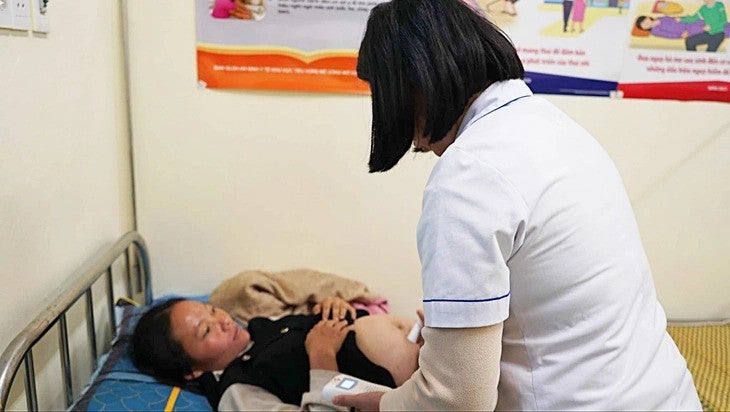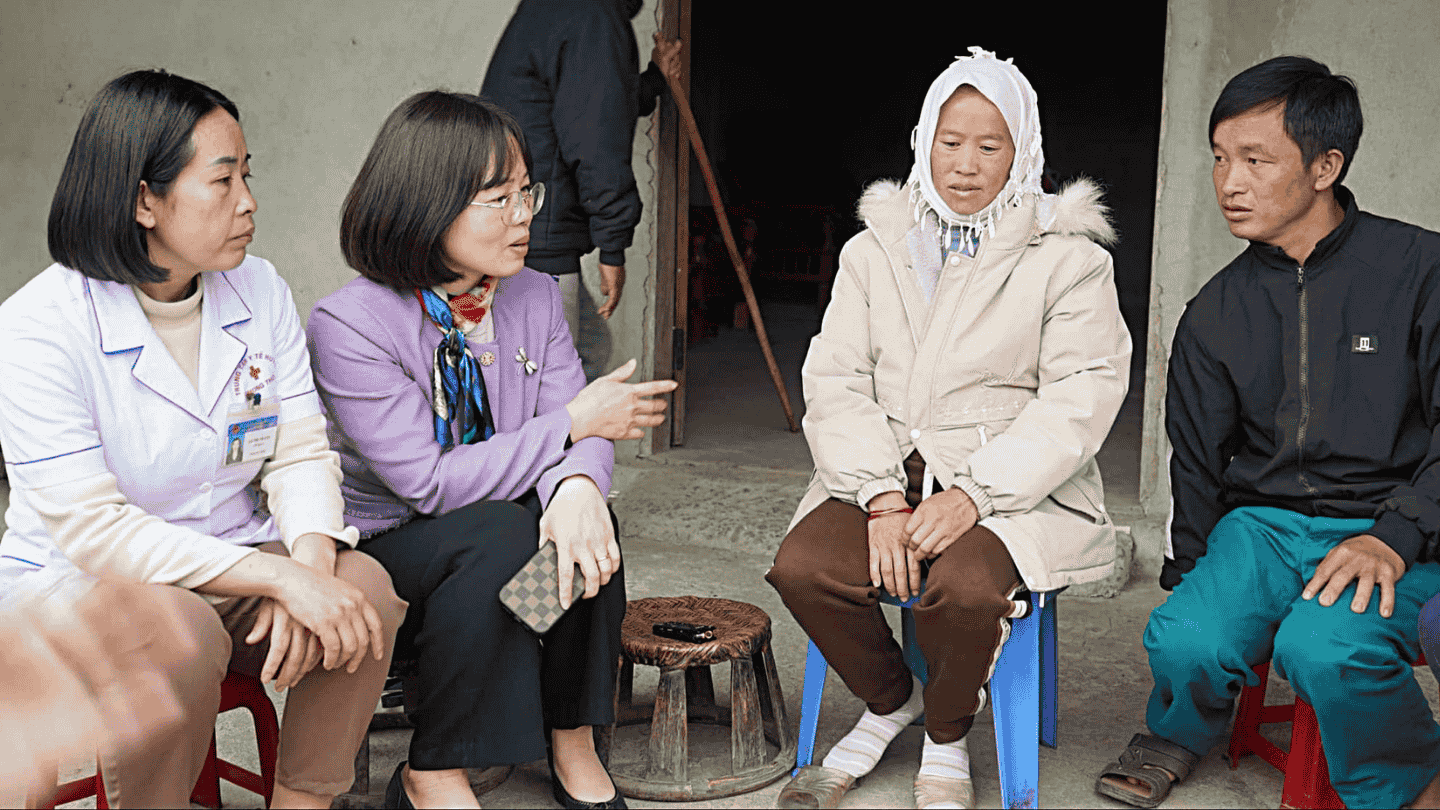There are children born on cold dirt floors, and others who never get the chance to let out their first cry.
Losing a Wife, Losing a Child to a Home Birth
In the remote village of Tô Y Phìn, Mồ Sì San commune, Phong Thổ district, Lai Châu province, people still recall the tragic death of Phùng Tả Mẩy while giving birth at home.
Her husband recounted that they had been expecting their fifth child. Throughout the pregnancy, Mẩy was healthy. Like many other women in Tô Y Phìn, she continued working in the fields, gathering firewood and bamboo shoots.
"I remember the day she went into labor so clearly," he said of February 18, 2022. "By dusk, she began to feel contractions, and they grew stronger. Just like the four times before, she gave birth at home—alone, and even bathed the baby herself. That night, she successfully delivered a healthy, pink-cheeked baby boy."
But unlike previous deliveries, the placenta did not expel, and she began to bleed heavily. The family urged her to go to the health station. Confident from four previous births, Mẩy refused. Just two hours later, the placenta still hadn't come out. She kept bleeding, her limbs grew cold, her skin turned pale—and she passed away.
Mẩy left behind her husband and five young children. The newborn never saw his mother’s face. The older siblings would never see their mother again.
In another village, Nà Trịa (Sam Kha commune, Sốp Cộp district, Sơn La), nearly two years have passed, but G.D.C. still lives with the pain of losing both his wife and their newborn in early 2023.
“In our village, many families give birth at home,” he said. “Some even have four or five kids without any issues. So people still say it’s fine to have babies at home.”
When his wife went into labor, it happened so fast that all he could do was call the traditional midwife who normally assisted women in the village. But 30 minutes after birth, the baby fell silent and didn’t survive. His wife, too, began hemorrhaging. Despite rushing her to the hospital, she died on the way.
Haunted with regret, he said, “I wish I had cared more during the pregnancy, taken her for check-ups, and brought her to a health facility for the birth. Maybe this wouldn’t have happened.”
“We’ve Always Done It This Way”
At Mù Sang village’s health station in Phong Thổ, Lai Châu, a pregnant woman named Giàng Thị Súa, pregnant with her fourth child, shared that all three of her previous children were born at home.
When asked if she wasn’t afraid of the risks, she replied shyly, “Of course I was. But my husband and mother-in-law said it’s fine. Everyone here always gives birth at home, so I just followed that. Some of us do want to go to the health station, but we feel embarrassed, and anyway, the custom is to deliver at home with help from someone we know. It’s just how it is here.”
It’s the same for Giàng A Lừng and Lý Thị Số, a young couple from Xin Chải village. Their first child was also born at home. “Our parents and grandparents all delivered at home, so we just followed the same way,” Lừng explained.
Pằng, 23, already has three children. The youngest is just over a month old—all were born at home. When asked why she didn’t go to the health station, she said: “It’s too far, and we don’t have money.”
Even though ethnic minority women in remote areas have health insurance and don’t need to pay hospital fees, many still choose to give birth at home, assuming it would be costly to go to a facility.
Additionally, many pregnant women don’t have the means for regular check-ups. In Hmong communities, villages are often located high in the mountains, with limited access to roads and health services.
Without antenatal care, women don’t know their due dates and are unprepared for labor. Newborns’ umbilical cords are often cut with household scissors or knives—or even sharp bamboo. These practices have tragically led to maternal and infant deaths during home births.
Maternal and Child Mortality Rates Remain High
According to statistics from the United Nations Population Fund (UNFPA), although in recent years the maternal mortality rate nationwide in Viet Nam has decreased to 46 per 100,000 live births, this number remains very high in mountainous areas and among ethnic minority regions (100–150 per 100,000 live births), particularly in the midland and northern mountainous regions and the Central Highlands.
A study has shown that among reported cases of maternal death in mountainous areas, the rate is often higher among certain ethnic groups such as the Hmong (60%) and the Thai ethnic group (17%). It is estimated that the risk of dying during pregnancy or childbirth for Hmong mothers is four times higher than that for Kinh mothers.
The main cause of maternal death in ethnic minority areas is home birth. Accordingly, maternal death cases that occurred at home or while on the way to the hospital account for 47.2%. This indicates that minority mothers are still delayed in reaching health facilities, and when facing critical conditions, it is already too late for emergency care.
Helpless in Convincing Pregnant Women

Having spent 18 years working with the people in the highland commune of Mù Sang, Phong Thổ district, Lai Châu province, Ms. Lò Thị Thanh, a physician working at Mù Sang Commune Health Station, shared that she sometimes feels helpless because she cannot persuade mothers to go to health facilities for prenatal checkups and childbirth.
"Because the custom of giving birth at home has been deeply ingrained from generation to generation, it cannot be changed overnight. Besides geographical constraints, there are also psychological barriers among ethnic minority people. Many women feel very shy and ashamed," Ms. Thanh shared.
Ms. Thanh said that Hmong women are very reluctant to undergo gynecological exams or give birth at the health station because they are afraid that "the physician (the health station doctor) will see them, and since we see the doctor every day, it would be embarrassing and shameful."
According to Ms. Thanh, in Hmong customs, only relatives, husbands, and mothers are allowed to see their “birth organ.” Just because of “shyness,” many women do not dare to go to medical facilities for delivery or prenatal checkups.
Ms. Mùa Thị Súa (24 years old, living in Mù Sang commune) also shared that women in her village often follow the husband’s and mother-in-law’s wishes to give birth at home. If the family does not bring them to the health station for delivery, then they just accept giving birth at home.
Urban Women Risk Their Lives Following the “Natural Birth” Trend
The “natural home birth” trend notably emerged in 2019. At that time, with the involvement of many ministries, sectors, mass media, and public opinion, this trend was suppressed. However, recently, this unscientific trend—posing many risks to mothers and newborns—has resurfaced on social media.
@Tuoi Tre/Duong Lieu


